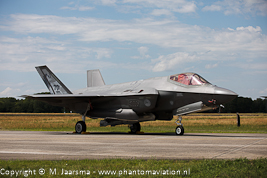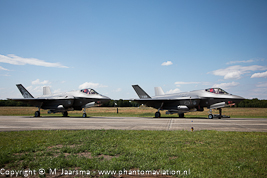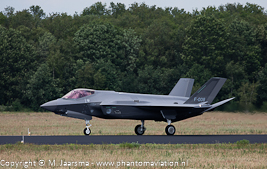|
Part of the operational test and evaluation
phase of the Lightning II is conducting a long range strike-mission.
This task was assigned to the RNLAF. Originally the plan was to strike a
target at a range in Hawaii but this was changed to The Netherlands.
On June 10 two 323 TES F-35A’s departed their
home base supported by one KDC-10 of 334 squadron based at Eindhoven AB.
After crossing the USA both aircraft landed at NAS Patuxent River,
Maryland while the tanker continued its journey to Bangor IAP, Maine.
From here the detachments prepared for their long range strike mission.
The planned departure of on June 12 was cancelled as the KDC-10 was
unserviceable. The next day the flight departed however the KDC-10 again
experienced problems resulting in all three aircraft landing at CFB
Goose Bay, Newfoundland and Labrador. Meanwhile the second KDC-10 had
departed France heading for a rendezvous with the fighters near
Greenland to escort them to The Netherlands. Right on time the two
flights joint, a few minutes later the F-35s had either returned to
Canada or landed at an airport in Greenland.
Roughly 200 kilometers before reaching the target – which was set up at
RNLAF gunnery range ‘De Vliehors’ on the island Vlieland - both pilots
started their preparation for the air strike. Both aircraft were armed
with two inert bombs (two GPS guided GBU-49s and two laser guided
GBU-12’s of 500 pound). At ‘De Vliehors a
JTAC team (Joint Terminal Attack Controllers) consisting Royal
Netherlands Army special forces (Korps Commandotroepen) guided the
Lightning’s to their target using a laptop sending the information about
their own and the target position. The target was created of 3 stacked
sea containers. The strike resulted in one bomb hitting the target
splitting the containers from top to bottom with the others smashing the
construction. After the aircraft completed their attack they turned
south heading to Volkel AB to take part in the RNLAF Luchtmachtdagen
(air show). The visit to the RNLAF Luchtmachtdagen was already rumored
for some time on the internet with the RNLAF confirming the aircraft had
taken off to conduct their test deployment concept in the morning of
June 13. Both aircraft landed after performing a touch and go around
22.00 (CEST). The total mission lasted around eight hours. Ground crews,
who were flown in by a USAF Boeing C-17A Globemaster III, with support
equipment, then started to work to get the aircraft ready for a their
new assignment. |





